brake sensor JEEP WRANGLER 2DOORS 2021 Owner handbook (in English)
[x] Cancel search | Manufacturer: JEEP, Model Year: 2021, Model line: WRANGLER 2DOORS, Model: JEEP WRANGLER 2DOORS 2021Pages: 330, PDF Size: 9.16 MB
Page 8 of 330
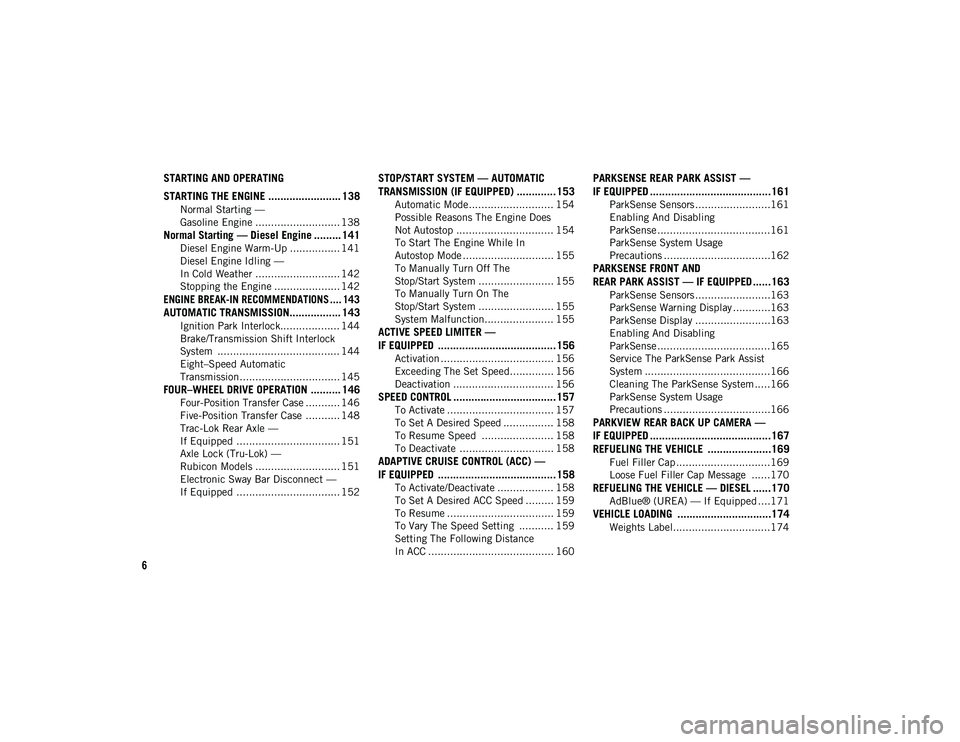
6
STARTING AND OPERATING
STARTING THE ENGINE ........................ 138
Normal Starting ŌĆö
Gasoline Engine ........................... 138
Normal Starting ŌĆö Diesel Engine ......... 141
Diesel Engine Warm-Up ................ 141
Diesel Engine Idling ŌĆö
In Cold Weather ........................... 142 Stopping the Engine ..................... 142
ENGINE BREAK-IN RECOMMENDATIONS .... 143
AUTOMATIC TRANSMISSION................. 143
Ignition Park Interlock................... 144
Brake/Transmission Shift Interlock
System ....................................... 144 EightŌĆōSpeed Automatic
Transmission................................ 145
FOURŌĆōWHEEL DRIVE OPERATION .......... 146
Four-Position Transfer Case ........... 146
Five-Position Transfer Case ........... 148
Trac-Lok Rear Axle ŌĆö
If Equipped ................................. 151 Axle Lock (Tru-Lok) ŌĆö
Rubicon Models ........................... 151 Electronic Sway Bar Disconnect ŌĆö
If Equipped ................................. 152
STOP/START SYSTEM ŌĆö AUTOMATIC
TRANSMISSION (IF EQUIPPED) .............153
Automatic Mode ........................... 154
Possible Reasons The Engine Does
Not Autostop ............................... 154 To Start The Engine While In
Autostop Mode ............................. 155 To Manually Turn Off The
Stop/Start System ........................ 155 To Manually Turn On The
Stop/Start System ........................ 155 System Malfunction...................... 155
ACTIVE SPEED LIMITER ŌĆö
IF EQUIPPED .......................................156
Activation .................................... 156
Exceeding The Set Speed.............. 156
Deactivation ................................ 156
SPEED CONTROL ..................................157
To Activate .................................. 157
To Set A Desired Speed ................ 158
To Resume Speed ....................... 158
To Deactivate .............................. 158
ADAPTIVE CRUISE CONTROL (ACC) ŌĆö
IF EQUIPPED .......................................158
To Activate/Deactivate .................. 158
To Set A Desired ACC Speed ......... 159
To Resume .................................. 159
To Vary The Speed Setting ........... 159
Setting The Following Distance
In ACC ........................................ 160
PARKSENSE REAR PARK ASSIST ŌĆö
IF EQUIPPED ........................................161
ParkSense Sensors ........................161
Enabling And Disabling
ParkSense ....................................161 ParkSense System Usage
Precautions ..................................162
PARKSENSE FRONT AND
REAR PARK ASSIST ŌĆö IF EQUIPPED ......163
ParkSense Sensors ........................163
ParkSense Warning Display ............163
ParkSense Display ........................163
Enabling And Disabling
ParkSense ....................................165 Service The ParkSense Park Assist
System ........................................166 Cleaning The ParkSense System .....166
ParkSense System Usage
Precautions ..................................166
PARKVIEW REAR BACK UP CAMERA ŌĆö
IF EQUIPPED ........................................167
REFUELING THE VEHICLE .....................169
Fuel Filler Cap ..............................169
Loose Fuel Filler Cap Message ......170
REFUELING THE VEHICLE ŌĆö DIESEL ......170
AdBlue┬« (UREA) ŌĆö If Equipped ....171
VEHICLE LOADING ...............................174
Weights Label...............................174
2020_JEEP_JL_WRANGLER_UG_RHD_UK.book Page 6
Page 82 of 330
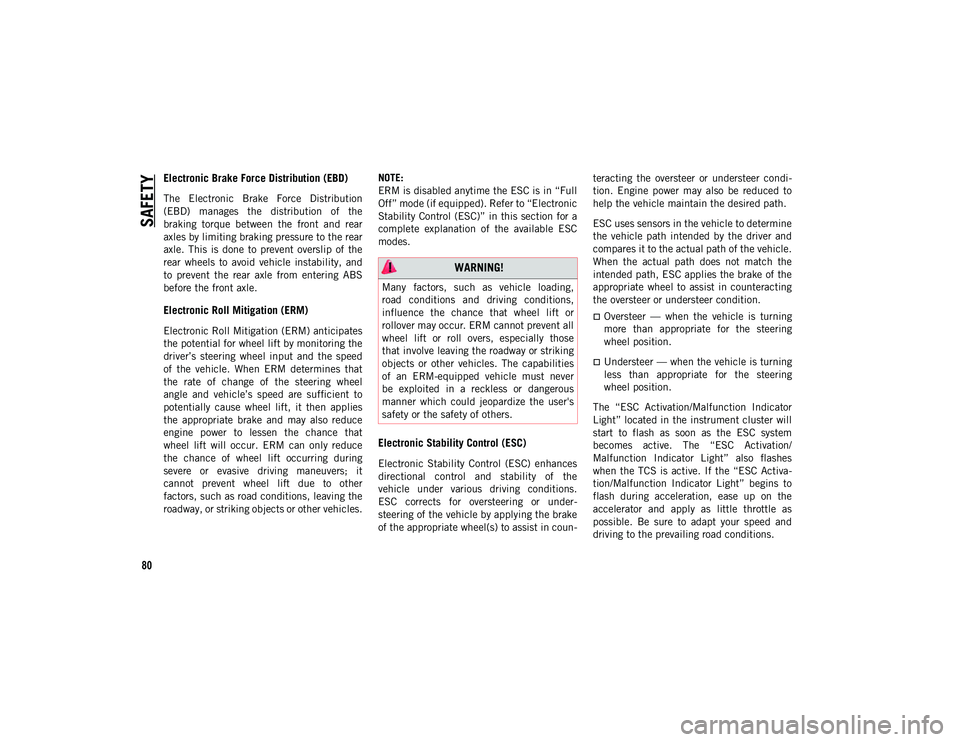
SAFETY
80
Electronic Brake Force Distribution (EBD)
The Electronic Brake Force Distribution
(EBD) manages the distribution of the
braking torque between the front and rear
axles by limiting braking pressure to the rear
axle. This is done to prevent overslip of the
rear wheels to avoid vehicle instability, and
to prevent the rear axle from entering ABS
before the front axle.
Electronic Roll Mitigation (ERM)
Electronic Roll Mitigation (ERM) anticipates
the potential for wheel lift by monitoring the
driverŌĆÖs steering wheel input and the speed
of the vehicle. When ERM determines that
the rate of change of the steering wheel
angle and vehicleŌĆÖs speed are sufficient to
potentially cause wheel lift, it then applies
the appropriate brake and may also reduce
engine power to lessen the chance that
wheel lift will occur. ERM can only reduce
the chance of wheel lift occurring during
severe or evasive driving maneuvers; it
cannot prevent wheel lift due to other
factors, such as road conditions, leaving the
roadway, or striking objects or other vehicles.NOTE:
ERM is disabled anytime the ESC is in ŌĆ£Full
OffŌĆØ mode (if equipped). Refer to ŌĆ£Electronic
Stability Control (ESC)ŌĆØ in this section for a
complete explanation of the available ESC
modes.
Electronic Stability Control (ESC)
Electronic Stability Control (ESC) enhances
directional control and stability of the
vehicle under various driving conditions.
ESC corrects for oversteering or under
-
steering of the vehicle by applying the brake
of the appropriate wheel(s) to assist in coun -teracting the oversteer or understeer condi
-
tion. Engine power may also be reduced to
help the vehicle maintain the desired path.
ESC uses sensors in the vehicle to determine
the vehicle path intended by the driver and
compares it to the actual path of the vehicle.
When the actual path does not match the
intended path, ESC applies the brake of the
appropriate wheel to assist in counteracting
the oversteer or understeer condition.
’ü»Oversteer ŌĆö when the vehicle is turning
more than appropriate for the steering
wheel position.
’ü»Understeer ŌĆö when the vehicle is turning
less than appropriate for the steering
wheel position.
The ŌĆ£ESC Activation/Malfunction Indicator
LightŌĆØ located in the instrument cluster will
start to flash as soon as the ESC system
becomes active. The ŌĆ£ESC Activation/
Malfunction Indicator LightŌĆØ also flashes
when the TCS is active. If the ŌĆ£ESC Activa -
tion/Malfunction Indicator LightŌĆØ begins to
flash during acceleration, ease up on the
accelerator and apply as little throttle as
possible. Be sure to adapt your speed and
driving to the prevailing road conditions.
WARNING!
Many factors, such as vehicle loading,
road conditions and driving conditions,
influence the chance that wheel lift or
rollover may occur. ERM cannot prevent all
wheel lift or roll overs, especially those
that involve leaving the roadway or striking
objects or other vehicles. The capabilities
of an ERM-equipped vehicle must never
be exploited in a reckless or dangerous
manner which could jeopardize the user's
safety or the safety of others.
2020_JEEP_JL_WRANGLER_UG_RHD_UK.book Page 80
Page 88 of 330
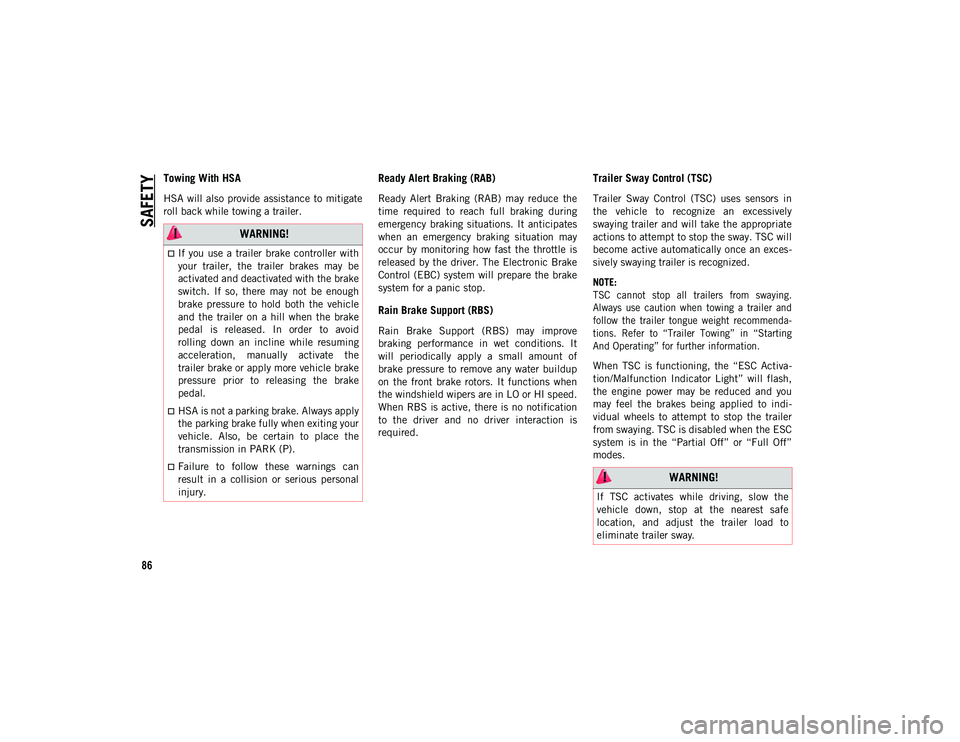
SAFETY
86
Towing With HSA
HSA will also provide assistance to mitigate
roll back while towing a trailer.
Ready Alert Braking (RAB)
Ready Alert Braking (RAB) may reduce the
time required to reach full braking during
emergency braking situations. It anticipates
when an emergency braking situation may
occur by monitoring how fast the throttle is
released by the driver. The Electronic Brake
Control (EBC) system will prepare the brake
system for a panic stop.
Rain Brake Support (RBS)
Rain Brake Support (RBS) may improve
braking performance in wet conditions. It
will periodically apply a small amount of
brake pressure to remove any water buildup
on the front brake rotors. It functions when
the windshield wipers are in LO or HI speed.
When RBS is active, there is no notification
to the driver and no driver interaction is
required.
Trailer Sway Control (TSC)
Trailer Sway Control (TSC) uses sensors in
the vehicle to recognize an excessively
swaying trailer and will take the appropriate
actions to attempt to stop the sway. TSC will
become active automatically once an exces-
sively swaying trailer is recognized.
NOTE:
TSC cannot stop all trailers from swaying.
Always use caution when towing a trailer and
follow the trailer tongue weight recommenda-
tions. Refer to ŌĆ£Trailer TowingŌĆØ in ŌĆ£Starting
And OperatingŌĆØ for further information.
When TSC is functioning, the ŌĆ£ESC Activa -
tion/Malfunction Indicator LightŌĆØ will flash,
the engine power may be reduced and you
may feel the brakes being applied to indi -
vidual wheels to attempt to stop the trailer
from swaying. TSC is disabled when the ESC
system is in the ŌĆ£Partial OffŌĆØ or ŌĆ£Full OffŌĆØ
modes.
WARNING!
’ü»If you use a trailer brake controller with
your trailer, the trailer brakes may be
activated and deactivated with the brake
switch. If so, there may not be enough
brake pressure to hold both the vehicle
and the trailer on a hill when the brake
pedal is released. In order to avoid
rolling down an incline while resuming
acceleration, manually activate the
trailer brake or apply more vehicle brake
pressure prior to releasing the brake
pedal.
’ü»HSA is not a parking brake. Always apply
the parking brake fully when exiting your
vehicle. Also, be certain to place the
transmission in PARK (P).
’ü»Failure to follow these warnings can
result in a collision or serious personal
injury. WARNING!
If TSC activates while driving, slow the
vehicle down, stop at the nearest safe
location, and adjust the trailer load to
eliminate trailer sway.
2020_JEEP_JL_WRANGLER_UG_RHD_UK.book Page 86
Page 89 of 330
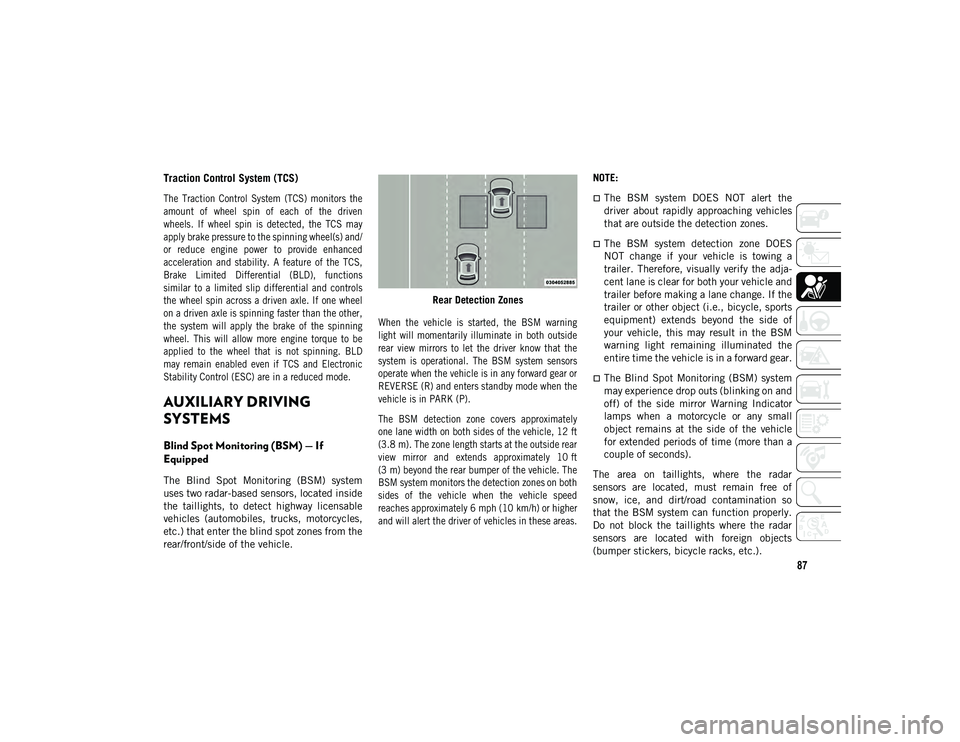
87
Traction Control System (TCS)
The Traction Control System (TCS) monitors the
amount of wheel spin of each of the driven
wheels. If wheel spin is detected, the TCS may
apply brake pressure to the spinning wheel(s) and/
or reduce engine power to provide enhanced
acceleration and stability. A feature of the TCS,
Brake Limited Differential (BLD), functions
similar to a limited slip differential and controls
the wheel spin across a driven axle. If one wheel
on a driven axle is spinning faster than the other,
the system will apply the brake of the spinning
wheel. This will allow more engine torque to be
applied to the wheel that is not spinning. BLD
may remain enabled even if TCS and Electronic
Stability Control (ESC) are in a reduced mode.
AUXILIARY DRIVING
SYSTEMS
Blind Spot Monitoring (BSM) ŌĆö If
Equipped
The Blind Spot Monitoring (BSM) system
uses two radar-based sensors, located inside
the taillights, to detect highway licensable
vehicles (automobiles, trucks, motorcycles,
etc.) that enter the blind spot zones from the
rear/front/side of the vehicle.Rear Detection Zones
When the vehicle is started, the BSM warning
light will momentarily illuminate in both outside
rear view mirrors to let the driver know that the
system is operational. The BSM system sensors
operate when the vehicle is in any forward gear or
REVERSE (R) and enters standby mode when the
vehicle is in PARK (P).
The BSM detection zone covers approximately
one lane width on both sides of the vehicle, 12 ft
(3.8 m). The zone length starts at the outside rear
view mirror and extends approximately 10 ft
(3 m) beyond the rear bumper of the vehicle. The
BSM system monitors the detection zones on both
sides of the vehicle when the vehicle speed
reaches approximately 6 mph (10 km/h) or higher and will alert the driver of vehicles in these areas.
NOTE:
’ü»The BSM system DOES NOT alert the
driver about rapidly approaching vehicles
that are outside the detection zones.
’ü»The BSM system detection zone DOES
NOT change if your vehicle is towing a
trailer. Therefore, visually verify the adja-
cent lane is clear for both your vehicle and
trailer before making a lane change. If the
trailer or other object (i.e., bicycle, sports
equipment) extends beyond the side of
your vehicle, this may result in the BSM
warning light remaining illuminated the
entire time the vehicle is in a forward gear.
’ü»The Blind Spot Monitoring (BSM) system
may experience drop outs (blinking on and
off) of the side mirror Warning Indicator
lamps when a motorcycle or any small
object remains at the side of the vehicle
for extended periods of time (more than a
couple of seconds).
The area on taillights, where the radar
sensors are located, must remain free of
snow, ice, and dirt/road contamination so
that the BSM system can function properly.
Do not block the taillights where the radar
sensors are located with foreign objects
(bumper stickers, bicycle racks, etc.).
2020_JEEP_JL_WRANGLER_UG_RHD_UK.book Page 87
Page 91 of 330
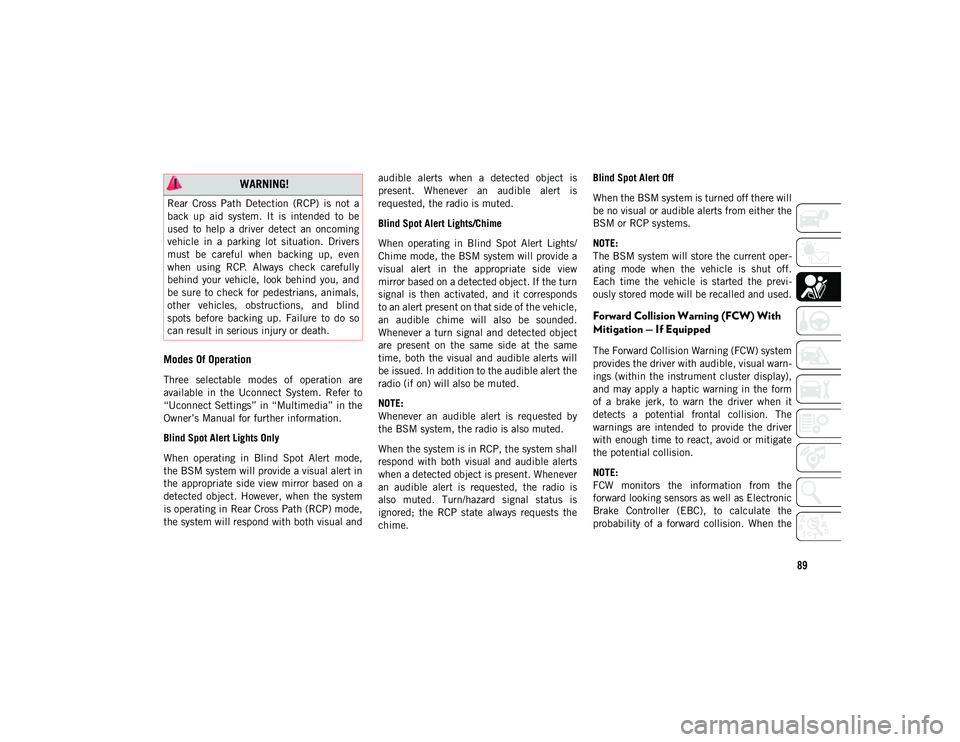
89
Modes Of Operation
Three selectable modes of operation are
available in the Uconnect System. Refer to
ŌĆ£Uconnect SettingsŌĆØ in ŌĆ£MultimediaŌĆØ in the
OwnerŌĆÖs Manual for further information.
Blind Spot Alert Lights Only
When operating in Blind Spot Alert mode,
the BSM system will provide a visual alert in
the appropriate side view mirror based on a
detected object. However, when the system
is operating in Rear Cross Path (RCP) mode,
the system will respond with both visual andaudible alerts when a detected object is
present. Whenever an audible alert is
requested, the radio is muted.
Blind Spot Alert Lights/Chime
When operating in Blind Spot Alert Lights/
Chime mode, the BSM system will provide a
visual alert in the appropriate side view
mirror based on a detected object. If the turn
signal is then activated, and it corresponds
to an alert present on that side of the vehicle,
an audible chime will also be sounded.
Whenever a turn signal and detected object
are present on the same side at the same
time, both the visual and audible alerts will
be issued. In addition to the audible alert the
radio (if on) will also be muted.
NOTE:
Whenever an audible alert is requested by
the BSM system, the radio is also muted.
When the system is in RCP, the system shall
respond with both visual and audible alerts
when a detected object is present. Whenever
an audible alert is requested, the radio is
also muted. Turn/hazard signal status is
ignored; the RCP state always requests the
chime.Blind Spot Alert Off
When the BSM system is turned off there will
be no visual or audible alerts from either the
BSM or RCP systems.
NOTE:
The BSM system will store the current oper
-
ating mode when the vehicle is shut off.
Each time the vehicle is started the previ -
ously stored mode will be recalled and used.
Forward Collision Warning (FCW) With
Mitigation ŌĆö If Equipped
The Forward Collision Warning (FCW) system
provides the driver with audible, visual warn -
ings (within the instrument cluster display),
and may apply a haptic warning in the form
of a brake jerk, to warn the driver when it
detects a potential frontal collision. The
warnings are intended to provide the driver
with enough time to react, avoid or mitigate
the potential collision.
NOTE:
FCW monitors the information from the
forward looking sensors as well as Electronic
Brake Controller (EBC), to calculate the
probability of a forward collision. When the
WARNING!
Rear Cross Path Detection (RCP) is not a
back up aid system. It is intended to be
used to help a driver detect an oncoming
vehicle in a parking lot situation. Drivers
must be careful when backing up, even
when using RCP. Always check carefully
behind your vehicle, look behind you, and
be sure to check for pedestrians, animals,
other vehicles, obstructions, and blind
spots before backing up. Failure to do so
can result in serious injury or death.
2020_JEEP_JL_WRANGLER_UG_RHD_UK.book Page 89
Page 141 of 330
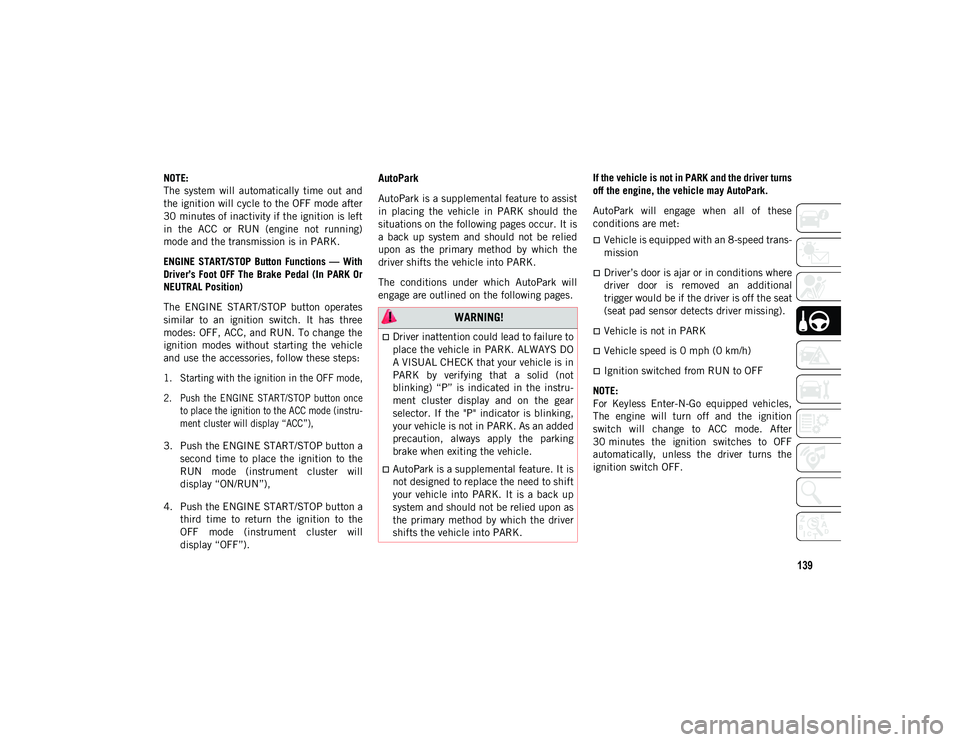
139
NOTE:
The system will automatically time out and
the ignition will cycle to the OFF mode after
30 minutes of inactivity if the ignition is left
in the ACC or RUN (engine not running)
mode and the transmission is in PARK.
ENGINE START/STOP Button Functions ŌĆö With
DriverŌĆÖs Foot OFF The Brake Pedal (In PARK Or
NEUTRAL Position)
The ENGINE START/STOP button operates
similar to an ignition switch. It has three
modes: OFF, ACC, and RUN. To change the
ignition modes without starting the vehicle
and use the accessories, follow these steps:
1. Starting with the ignition in the OFF mode,
2. Push the ENGINE START/STOP button onceto place the ignition to the ACC mode (instru -
ment cluster will display ŌĆ£ACCŌĆØ),
3. Push the ENGINE START/STOP button a second time to place the ignition to the
RUN mode (instrument cluster will
display ŌĆ£ON/RUNŌĆØ),
4. Push the ENGINE START/STOP button a third time to return the ignition to the
OFF mode (instrument cluster will
display ŌĆ£OFFŌĆØ).AutoPark
AutoPark is a supplemental feature to assist
in placing the vehicle in PARK should the
situations on the following pages occur. It is
a back up system and should not be relied
upon as the primary method by which the
driver shifts the vehicle into PARK.
The conditions under which AutoPark will
engage are outlined on the following pages. If the vehicle is not in PARK and the driver turns
off the engine, the vehicle may AutoPark.
AutoPark will engage when all of these
conditions are met:
’ü»Vehicle is equipped with an 8-speed trans-
mission
’ü»DriverŌĆÖs door is ajar or in conditions where
driver door is removed an additional
trigger would be if the driver is off the seat
(seat pad sensor detects driver missing).
’ü»Vehicle is not in PARK
’ü»Vehicle speed is 0 mph (0 km/h)
’ü»Ignition switched from RUN to OFF
NOTE:
For Keyless Enter-N-Go equipped vehicles,
The engine will turn off and the ignition
switch will change to ACC mode. After
30 minutes the ignition switches to OFF
automatically, unless the driver turns the
ignition switch OFF.
WARNING!
’ü»Driver inattention could lead to failure to
place the vehicle in PARK. ALWAYS DO
A VISUAL CHECK that your vehicle is in
PARK by verifying that a solid (not
blinking) ŌĆ£PŌĆØ is indicated in the instru -
ment cluster display and on the gear
selector. If the "P" indicator is blinking,
your vehicle is not in PARK. As an added
precaution, always apply the parking
brake when exiting the vehicle.
’ü»AutoPark is a supplemental feature. It is
not designed to replace the need to shift
your vehicle into PARK. It is a back up
system and should not be relied upon as
the primary method by which the driver
shifts the vehicle into PARK.
2020_JEEP_JL_WRANGLER_UG_RHD_UK.book Page 139
Page 142 of 330

STARTING AND OPERATING
140
If the vehicle is not in PARK and the driver exits
the vehicle with the engine running, the vehicle
may AutoPark.
AutoPark will engage when all of these
conditions are met:
’ü»Vehicle is equipped with an 8-speed trans-
mission
’ü»DriverŌĆÖs door is ajar or in conditions where
driver door is removed an additional
trigger would be if the driver is off the seat
(seat pad sensor detects driver missing).
’ü»Vehicle is not in PARK
’ü»DriverŌĆÖs door is removed
’ü»Vehicle speed is 1.2 mph (2.0 km/h) orless
’ü»DriverŌĆÖs seat belt is unbuckled
’ü»DriverŌĆÖs door is ajar
’ü»Brake pedal is not depressed
The MESSAGE ŌĆ£AutoPark Engaged Shift to P
then Shift to Gear ŌĆØ will display in the instru -
ment cluster. NOTE:
In some cases the ParkSense graphic will be
displayed in the instrument cluster. In these
cases, the shifter must be returned to ŌĆ£PŌĆØ to
select desired gear.
If the driver shifts into PARK while moving, the
vehicle may AutoPark.
AutoPark will engage
ONLY when vehicle
speed is 1.2 mph (2.0 km/h) or less.
The MESSAGE ŌĆ£Vehicle Speed is Too High to
Shift to P ŌĆØ will be displayed in the instrument
cluster if vehicle speed is above 1.2 mph
(2.0 km/h). 4WD LOW
AutoPark will be disabled when operating the
vehicle in 4WD LOW.
The MESSAGE ŌĆ£
AutoPark Disabled ŌĆØ will be
displayed in the instrument cluster.
Additional customer warnings will be given
when both of these conditions are met:
’ü»Vehicle is not in PARK
’ü»DriverŌĆÖs door is ajar
The MESSAGE ŌĆ£ AutoPark Not Engaged ŌĆØ will
be displayed in the instrument cluster. A
warning chime will continue until you shift
the vehicle into PARK or the driverŌĆÖs door is
closed.
ALWAYS DO A VISUAL CHECK
that your vehicle
is in PARK by looking for the "P" in the
instrument cluster display and on the shifter.
As an added precaution, always apply the
parking brake when exiting the vehicle.
WARNING!
If vehicle speed is above 1.2 mph
(2.0 km/h), the transmission will default
to NEUTRAL until the vehicle speed drops
below 1.2 mph (1.9 km/h). A vehicle left
in the NEUTRAL position can roll. As an
added precaution, always apply the
parking brake when exiting the vehicle.
2020_JEEP_JL_WRANGLER_UG_RHD_UK.book Page 140
Page 160 of 330
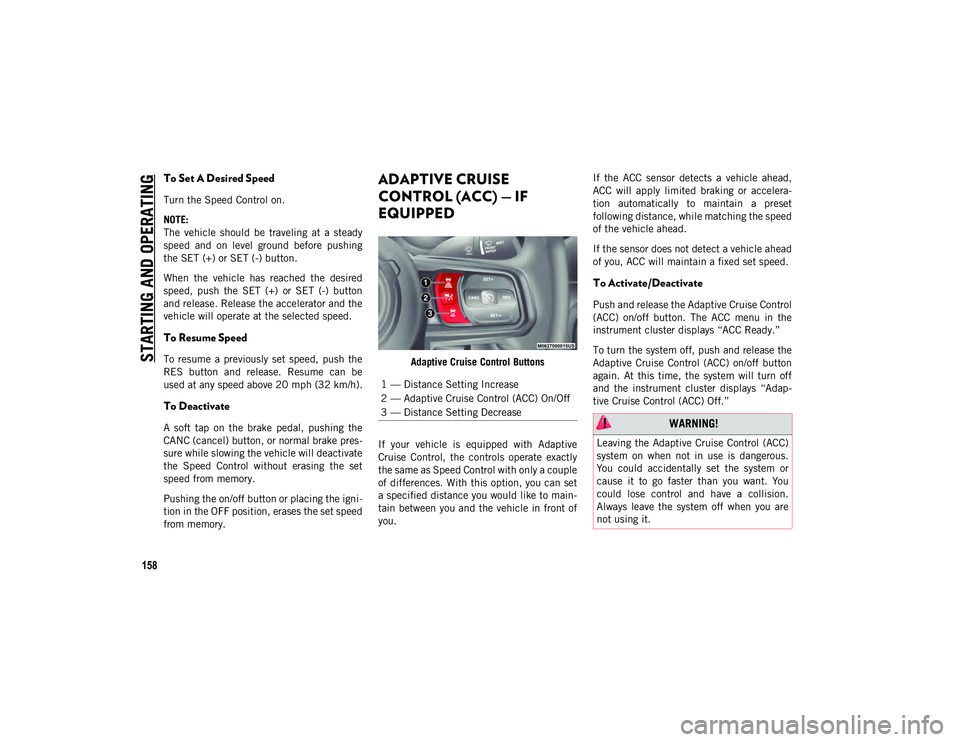
STARTING AND OPERATING
158
To Set A Desired Speed
Turn the Speed Control on.
NOTE:
The vehicle should be traveling at a steady
speed and on level ground before pushing
the SET (+) or SET (-) button.
When the vehicle has reached the desired
speed, push the SET (+) or SET (-) button
and release. Release the accelerator and the
vehicle will operate at the selected speed.
To Resume Speed
To resume a previously set speed, push the
RES button and release. Resume can be
used at any speed above 20 mph (32 km/h).
To Deactivate
A soft tap on the brake pedal, pushing the
CANC (cancel) button, or normal brake pres-
sure while slowing the vehicle will deactivate
the Speed Control without erasing the set
speed from memory.
Pushing the on/off button or placing the igni -
tion in the OFF position, erases the set speed
from memory.
ADAPTIVE CRUISE
CONTROL (ACC) ŌĆö IF
EQUIPPED
Adaptive Cruise Control Buttons
If your vehicle is equipped with Adaptive
Cruise Control, the controls operate exactly
the same as Speed Control with only a couple
of differences. With this option, you can set
a specified distance you would like to main -
tain between you and the vehicle in front of
you. If the ACC sensor detects a vehicle ahead,
ACC will apply limited braking or accelera
-
tion automatically to maintain a preset
following distance, while matching the speed
of the vehicle ahead.
If the sensor does not detect a vehicle ahead
of you, ACC will maintain a fixed set speed.
To Activate/Deactivate
Push and release the Adaptive Cruise Control
(ACC) on/off button. The ACC menu in the
instrument cluster displays ŌĆ£ACC Ready.ŌĆØ
To turn the system off, push and release the
Adaptive Cruise Control (ACC) on/off button
again. At this time, the system will turn off
and the instrument cluster displays ŌĆ£Adap -
tive Cruise Control (ACC) Off.ŌĆØ
1 ŌĆö Distance Setting Increase
2 ŌĆö Adaptive Cruise Control (ACC) On/Off
3 ŌĆö Distance Setting Decrease
WARNING!
Leaving the Adaptive Cruise Control (ACC)
system on when not in use is dangerous.
You could accidentally set the system or
cause it to go faster than you want. You
could lose control and have a collision.
Always leave the system off when you are
not using it.
2020_JEEP_JL_WRANGLER_UG_RHD_UK.book Page 158
Page 192 of 330
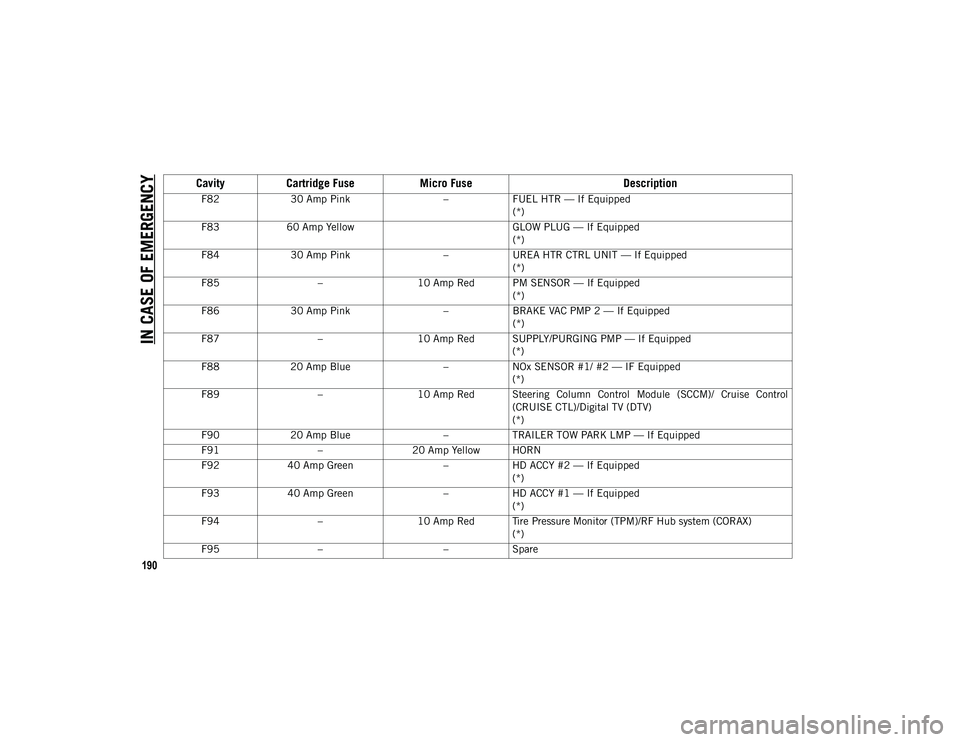
IN CASE OF EMERGENCY
190
F8230 Amp Pink ŌĆōFUEL HTR ŌĆö If Equipped
(*)
F83 60 Amp Yellow GLOW PLUG ŌĆö If Equipped
(*)
F84 30 Amp Pink ŌĆōUREA HTR CTRL UNIT ŌĆö If Equipped
(*)
F85 ŌĆō10 Amp Red PM SENSOR ŌĆö If Equipped
(*)
F86 30 Amp Pink ŌĆōBRAKE VAC PMP 2 ŌĆö If Equipped
(*)
F87 ŌĆō10 Amp Red SUPPLY/PURGING PMP ŌĆö If Equipped
(*)
F88 20 Amp Blue ŌĆōNOx SENSOR #1/ #2 ŌĆö IF Equipped
(*)
F89 ŌĆō10 Amp Red Steering Column Control Module (SCCM)/ Cruise Control
(CRUISE CTL)/Digital TV (DTV)
(*)
F90 20 Amp Blue ŌĆōTRAILER TOW PARK LMP ŌĆö If Equipped
F91 ŌĆō20 Amp Yellow HORN
F92 40 Amp Green ŌĆōHD ACCY #2 ŌĆö If Equipped
(*)
F93 40 Amp Green ŌĆōHD ACCY #1 ŌĆö If Equipped
(*)
F94 ŌĆō10 Amp Red Tire Pressure Monitor (TPM)/RF Hub system (CORAX)
(*)
F95 ŌĆō ŌĆōSpare
Cavity Cartridge Fuse Micro Fuse Description
2020_JEEP_JL_WRANGLER_UG_RHD_UK.book Page 190